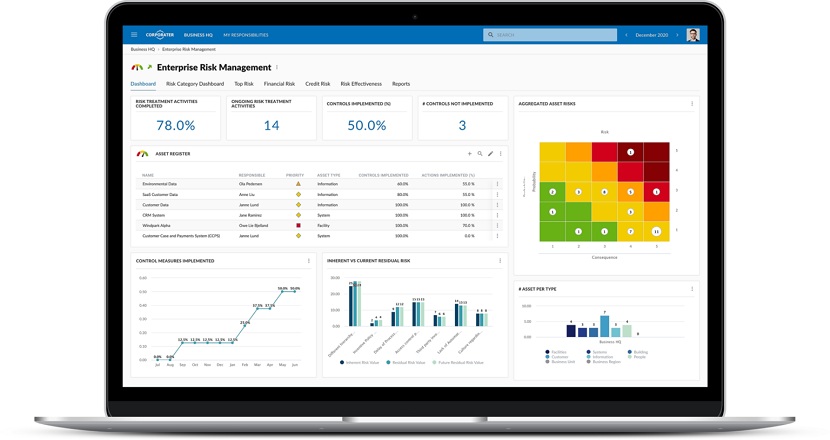The Impact of Leadership and Team Dynamics in Effective ERM Implementation” refers to how the effectiveness of Enterprise Risk Management (ERM) is significantly influenced by the leadership styles and the dynamics within the team responsible for its execution. Leadership in this context goes beyond just setting directives; it involves actively fostering a culture of risk awareness and encouraging open communication across all levels of the organization.
The dynamics of the team ERM Implementation, which often comprises individuals from various departments with different expertise. ERM Implementation play a crucial role in identifying, assessing and managing risks effectively. A cohesive team that collaborates well can leverage diverse perspectives to anticipate potential risks and develop robust strategies to mitigate them. This heading emphasizes the critical role that leadership and teamwork play in navigating the complexities of risk management and ensuring the resilience and success of an organization in the face of various challenges.
Introduction to Enterprise Risk Management (ERM)
Enterprise Risk Management (ERM) is a crucial aspect of modern business operations, involving a comprehensive approach to identifying, assessing, and managing risks across an organization. ERM is not just about mitigating threats but also about identifying opportunities for growth and improvement.
The Role of the Board of Directors in ERM
The board of directors plays a pivotal role in ERM Implementation often participating actively in risk oversight. Their involvement can range from forming dedicated risk committees to having board representatives directly engaged in the ERM process.
The CEO’s Involvement in Risk Management
The CEO’s engagement in the ERM team is vital. A CEO who actively participates and champions the importance of risk management significantly enhances the effectiveness of the ERM program.
Chief Risk Officer: The ERM Team Leader
The Chief Risk Officer (CRO) typically heads the ERM team, focusing on risk response and continuous improvement in risk identification and management. This role has evolved beyond financial risks to encompass a broader range of challenges across industries.
The Chief Audit Officer’s Role in ERM
In many organizations, the auditing function, which might include a large team, plays a key role in managing the ERM Implementation process, especially in the absence of a formal risk management committee.
Managing Day-to-Day Risks
The Chief Operating Officer (COO) is integral to ERM, dealing with the daily administration and operational risks, ensuring smooth business operations at all levels.
The CFO’s Financial Risk Management
The Chief Financial Officer (CFO) is inherently involved in risk management, focusing on risks to revenue, profitability, and financial impacts, playing a leading role in most organizations.
The Chief Legal Officer in Risk Management
The Chief Legal Officer or General Counsel deals with legal matters, including potential liability issues, making them a key player in the ERM team.
The Chief Privacy Officer’s Role in Data Protection
In today’s digital age, the Chief Privacy Officer ensures compliance with data protection regulations, a critical aspect of ERM Implementation.
The Chief Compliance Officer’s Governance Role
The Chief Compliance Officer ensures adherence to laws and regulations, encompassing a broad range of issues from data privacy to worker safety.
The CIO’s Role in Managing Technology Risks
The Chief Information Officer (CIO) addresses risks associated with technology, ensuring business continuity and minimizing operational risks.
The CISO: Cybersecurity and Risk Management
The Chief Information Security Officer (CISO) is responsible for the organization’s cybersecurity, playing a crucial role in managing risks related to networks, systems, and software.
The CHRO: Managing Workforce-Related Risks
The Chief Human Resources Officer (CHRO) handles risks related to the workforce, an essential aspect of ERM Implementation.
The Chief Strategy Officer’s Role in Aligning ERM with Business Goals
The Chief Strategy Officer ensures that risk management aligns with the enterprise’s strategic business objectives.
The Chief Sustainability Officer: ESG and Risk Management
The Chief Sustainability Officer focuses on Environmental, Social, and Governance (ESG) issues, integrating them into the ERM Implementation strategy.
The Chief Digital Officer’s Role in Innovation and Risk
The Chief Digital Officer oversees innovation and transformation, managing the risks associated with these processes.
The Chief Communications Officer: Managing Reputation Risks
The Chief Communications Officer plays a critical role in managing risks related to the organization’s reputation and stakeholder communication.
The Importance of Department Managers in ERM Implementation
Department heads and line-of-business leaders are crucial in understanding and managing risks in their respective areas.
The Role of Staff in Supporting ERM
Employees contribute to ERM by practicing good cyber hygiene and alerting management to potential risks.
Conclusion:
Effective ERM Implementation requires a collaborative effort across various roles within an organization, each contributing their expertise to manage risks and seize opportunities.
FAQs
What is the primary goal of Enterprise Risk Management?
- The primary goal of ERM is to manage the full scope of an organization’s risks effectively, balancing downside volatility with potential upside opportunities.
How does the CEO’s involvement impact ERM?
- A CEO actively involved in ERM significantly enhances the program’s effectiveness by championing the importance of risk management.
What role does the Chief Risk Officer play in ERM?
- The CRO chairs the ERM team, focusing on risk response, identification, and management, often encompassing a wide range of risks across different industries.
Why is the Chief Privacy Officer important in ERM?
- The Chief Privacy Officer ensures compliance with data protection laws and regulations, a critical aspect of managing digital and privacy risks in an organization.
How do staff members contribute to ERM?
- Staff members contribute to ERM Implementation by practicing good cyber hygiene, reporting perceived risks and suggesting ways to manage risks effectively.





Leave a Reply